Types of Pine Trees in Florida (Pictures) – Identification Guide
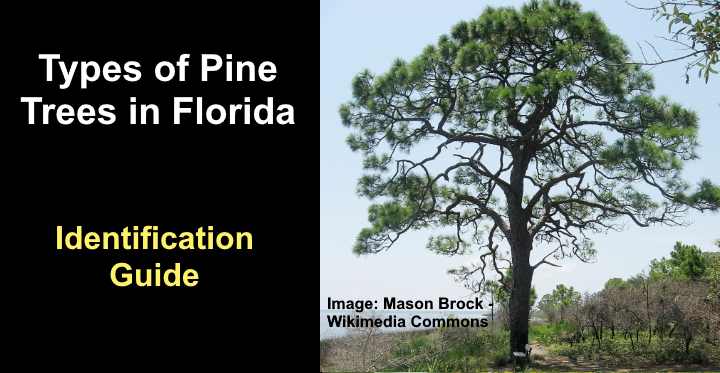
Many species of pine trees grow well in Florida’s unique climate. Pine trees are typically cold-hardy coniferous trees, known for their evergreen pine-needle foliage and hardiness in freezing temperatures. Despite this fact, some pine trees in Florida thrive. For example, the longleaf pine, shortleaf pine, loblolly pine, and spruce pine are found throughout the Sunshine State.
Florida pine trees thrive in sandy soil and withstand the heat, humidity, and coastal sea air that Florida is known for. The slash pine thrives in all areas of the state, from Florida’s Panhandle down to the Florida Keys. Other types of Florida pines — Loblolly pine, Pond Pine, and Shortleaf pine — are less tolerant of hot weather and grow best in the regions north of Orlando.
Are you interested in knowing the nine species of Florida pine trees — seven native and two non-native varieties? If so, then please read on. This article is a guide to identifying the various pine tree varieties common in the southeastern United States.
Florida Pine Tree Facts
Florida pine trees are cone-bearing plants in the genus Pinus and the coniferous evergreen family Pinaceae. There are 126 species of pine, seven of which are native to Florida. The pines are identified by their needle-like leaves growing in small bunches, brown cones, and reddish-gray peeling bark.
Like most trees in the Pinus genus, pine trees in Florida thrive in full sun, and acidic, well-drained soils. Typically, pine trees have a medium to rapid growth rate, open rounded habit, and crown that is generally at least halfway up the trunk.
Florida pines are in the subgenus Pinus classed as yellow or diploxylon pine trees.
Florida pine trees typically thrive in USDA zones 7 through 10; however, the slash pine (Pinus elliottii) grows well in Zone 11.
Pine trees make for attractive ornamental trees in a landscape. The evergreen foliage retains its light to dark green color throughout the year. In addition, the fast-growing Florida pines have an important use in the commercial timber industry.
Florida Pine Tree Needles
Needles growing on pine trees are one of the most recognizable factors. The slender needle leaves are typically bundled together in groups of two or three, growing on reddish woody twigs. Florida pine tree needles range in length from 2” to 18” (5 – 45 cm). The needles can be dark-green, bluish-green, or silvery-green.
The appropriately-named longleaf pine (Pinus palustris) has the longest needles of all the pines native to Florida. The sand pine (Pinus clausa) has the shortest. Pine needles also contain resin pockets with a characteristic pine aroma when crushed.
One way to identify Florida pines is by the number of needles in a bundle. Pine trees that start with “S” — shortleaf, spruce, and sand — have needles growing in twos. Florida pines beginning with “L” — longleaf and loblolly — have needles in bunches of threes, and the slash pine (starting “SL”) has needle bunches in twos and threes.
Florida Pine Tree Cones
Seed cones on Florida pines are identified by their light brown scales arranged in a spiral pattern. The stiff, durable, woody cones can be egg-shaped, cylindrical, or conical-shaped cones containing pollen or seeds, depending on if the cones are male or female. Typically, Florida pine cones measure between 1.5” and 10” (4 – 25 cm) long.
Seed cones are another way to identify species of native Florida pines. Species of yellow pine cones have scales with a diamond-shaped base (umbo) that usually has a sharp point. The umbo’s shape can often help identify the pine tree species. Pine tree cones typically take two years to mature.
Florida Pine Tree Bark
Bark on Florida pine trees is typically thick and scaly. A grayish outer bark peels away to reveal brownish-red bark. The reddish pine tree bark thickens as the tree ages, developing into irregular flaky plates. The branches of pine trees are arranged in whorls around the trunk.
Identifying a species of Florida pine tree by its bark can be tricky. This is because the bark color and texture within a particular pine tree species vary from tree to tree.
How to Identify Florida Pine Trees
Florida pine trees are identified by the size of the green to bluish-green needle-like leaves, the shape of seed-bearing cones, and gray or reddish-brown or gray bark. Florida pines tend to have pointed cones, and the needles grow in bundles of twos or threes. Also, consider the tree’s height when identifying a Florida pine.
Types of Pine Trees in Florida (With Pictures) – Identification Guide
Here are the types of pine trees growing in Florida.
Longleaf Pine (Pinus palustris)
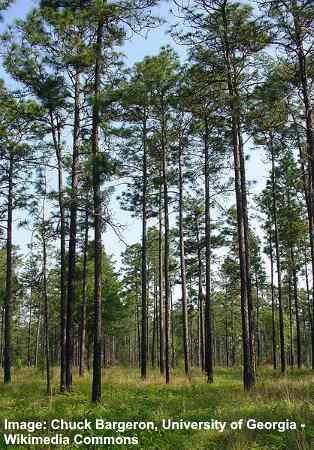
Longleaf pines are native to Florida and are identified by long needles and trunks
The longleaf pine is a tall, stately evergreen conifer native to Florida. The pine tree has a recognizable straight trunk and short branches, forming an irregular crown. The long slender green needles grow in bundles of three. Longleaf pine cones are exceedingly large and have a triangular shape.
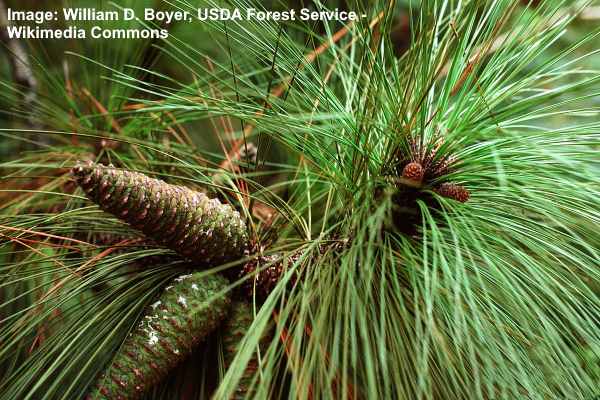
Longleaf pine needles and immature cones
The longleaf pine thrives in USDA zones 7 through 10 in full sun and acidic, well-drained soil. This large pine tree grows through north Florida, along the Gulf coast, and south as far as Lake Okeechobee. This pine species is the largest native southern pine tree growing up to 120 ft. (36 m) tall.
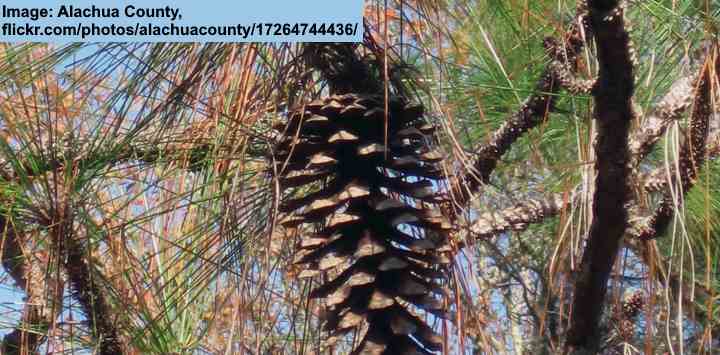
A mature cone of longleaf pine
Another identifying feature of the longleaf pine is the thick, orange-brown plates that form as the tree matures.
Florida pine tree needles: Longleaf pine needles measure 8” to 18” (20 – 45 cm) long and have finely serrated margins. The long drooping silvery-green needles grow in dense tufts of three.
Florida pine tree cones: Longleaf pine cones are reddish-brown and range from 6” to 10” (15 – 25 cm) long — the largest of all the native Florida pine trees.
Shortleaf Pine (Pinus echinata)
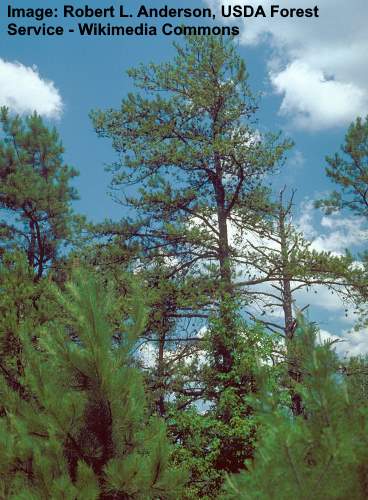
Shortleaf pines have shorter needles and smaller cones than longleaf pines
Native to the southeastern United States, the shortleaf pine is a tall coniferous tree identified by its straight trunk. The tree features blueish-green needles in clusters of twos or threes measuring 3” to 5” (7.5 – 12 cm) long. Other identifying characteristics are small, pointed woody cones and reddish-brown plates covering the tall trunk.
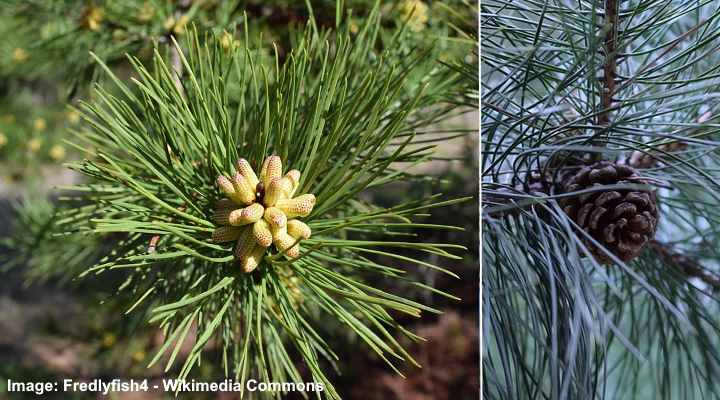
Shortleaf pine needles, male cones (left) and female cone (right)
The native shortleaf pine thrives in USDA zones 6 through 9. Like most pines, the shortleaf pine tree performs best in full sun and sandy or loamy soil. The coniferous Florida tree grows best in the north of the state throughout the Panhandle.
Shortleaf pine trees grow between 65 and 100 ft. (20 – 30 m) tall. The pine tree grows in the same native habitat as the Spruce pine, making identification tricky. However, compared to the spruce pine, the shortleaf pine has smaller cones.
Florida pine tree needles: Identify shortleaf pine trees by slender bluish-green needles growing in clusters of two.
Florida pine tree cones: Shortleaf pine cones are identified by their small size measuring 1.5” to 2.5” (4 – 6 cm) long. The thin pine cone scales tend to be flexible when open.
Loblolly Pine (Pinus taeda)
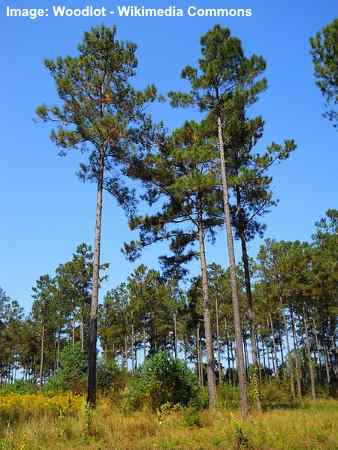
The tall Loblolly pines are very common in south-east USA
The loblolly pine tree is one of the most common Florida pines with a pyramidal to oval crown, thick grayish bark that forms flaky plates, and long 8” (20 cm) needles. Other features of this pine are sharply-pointed conical cones and yellow or purple flowers.
Loblolly pines are the fastest-growing pines in Florida. The native conifers thrive in USDA zones 6 through 9 and perform well throughout the northern regions of the Sunshine State. The tree grows 90 to 100 ft. (27 – 30 m) tall.

Loblolly pine needles and female cones
Florida pine tree needles: The loblolly pine is identified by its yellowish-green needles growing 6” to 10” (15 – 25 cm) long.
Florida pine tree cones: Identifiable features of loblolly pine cones are their conical shape, measuring 2.5” to 4” (6 – 10 cm) long. The pine seed cones have sharp prickles.
Slash Pine (Pinus elliottii)

Slash pine has long needles and is native to southeastern USA
Slash pine trees are one of the most common pine trees growing throughout Florida. The Florida pine’s identifying features are its egg-shaped crown, dark blue-green needle leaves growing 5” to 11” (13 – 28 cm) long, and ovoid seed cones growing singularly or in pairs.
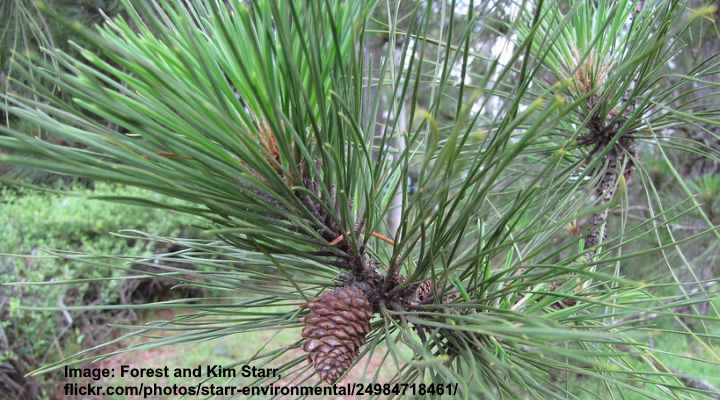
Slash pine needles and a cone
Slash pine trees are found in Florida from Jacksonville and Tallahassee in the north to Miami and Key West in the south. Slash pines are suitable for growing in USDA zones 8 through 11. They are also called the southern Florida pines. The pine tree grows 60 to 100 ft. (18 – 30 m) tall.
Florida pine tree needles: Slash pine needles are recognized by their dark, blue-green color and long length.
Florida pine tree cones: Slash pine tree cones measure 3” to 6” (7.5 – 15 cm) long, have a glossy brown sheen, and fine prickles on the scales.
Pond Pine (Pinus serotina)
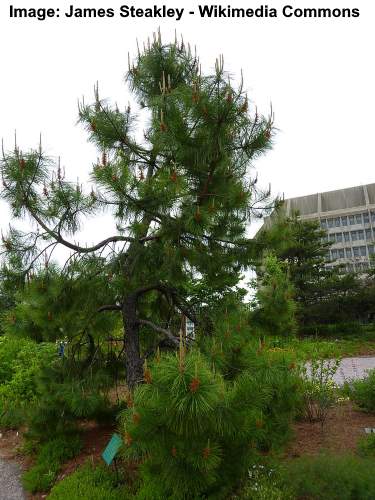
Pond pine is native to Florida and grows in poorly drained soil
Pond pine trees are native Florida conifers with yellowish-green needles bundled in groups of three. Features of the pine tree include yellow-brown round cones consisting of flat scales, and a spreading, rounded habit. The pond pine tree thrives in poorly-drained soil and woodlands, and its cones typically only open after a fire.
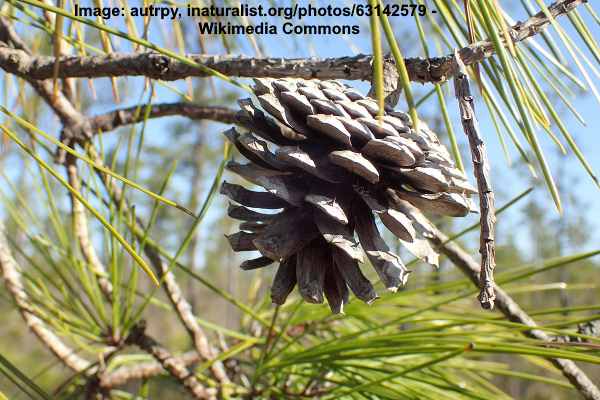
Pond pine cone
Pond pine trees thrive in USDA zones 7 through 9, planted in full sun and sandy or loamy soil. In ideal conditions, the hardy pine tree performs well in north Florida and south to Lake Placid. Pond pines grow up to 70 ft. (21 m) high.
Florida pine tree needles: Pond pine tree needles typically grow in bundles of threes and measure 5” to 6.5” (12 – 16 cm) long.
Florida pine tree cones: Pond pine cones are small, yellowish-brown rounded cones with prickly scales.
Sand Pine (Pinus Clausa)
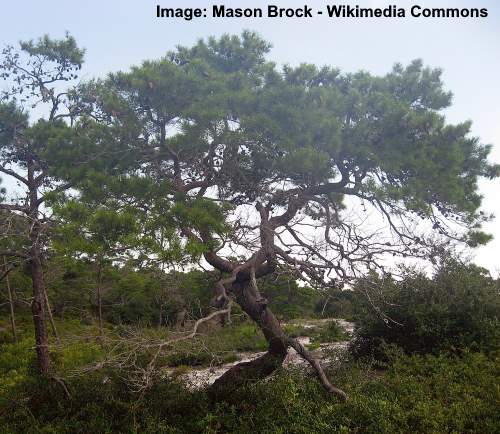
Sand pines are small to medium sized Florida trees identified by their twisted branches
The sand pine is a common conifer growing in Florida’s Atlantic and Gulf coastal areas. The small to medium-sized pine tree has a conical, spreading crown with a characteristic twisted branching growth habit. The pine tree’s green needles and pale, brown-colored cones measure 2” to 3” (5 – 7.5 cm) long.
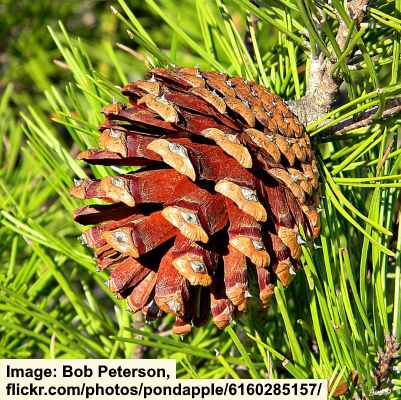
Sand pine cone
Short-lived sand pine trees thrive in USDA zones 9 and 10 and perform well in poor, sandy soils. The heat-loving shrub-like conifer tree measures 16 to 33 ft. (5 – 10 m) tall.
Florida pine tree needles: Sand pine tree needles grow in pairs and are recognized by their twisted, finely serrated margins.
Florida pine tree cones: Sand pine cones are cylindrical tan-colored or reddish-brown woody cones that grow around 3” (7.5 cm) long.
Spruce Pine (Pinus glabra)

Spruce pine is native to Florida and is very tall
The spruce pine is a native Florida coniferous evergreen pine tree with silvery-gray needles that are spirally twisted. As the Florida pine tree matures, it develops an eye-catching rounded to oval crown. The beautiful pine can reach heights of 80 to 115 ft. (25 – 35 m) tall and up to 30 ft. (10 m) wide.
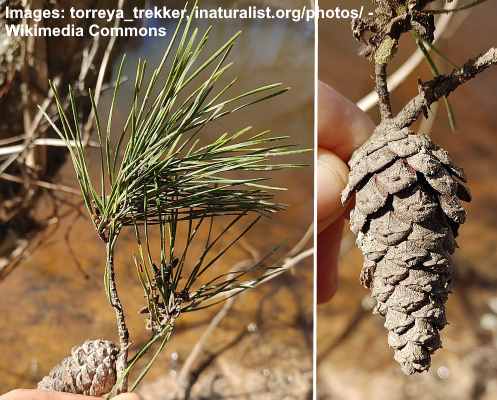
Spruce pine needles and a cone
The spruce pine thrives in USDA zones 7 through 9 and performs well in sunny locations, growing in sandy, loamy soils. In addition, this Florida pine tree is one of the most shade-tolerant pines growing in the state.
Florida pine tree needles: Spruce pine needles are dark green that become grayish-silver as the tree matures. Needles measure 3.5” to 4” (9 – 10 cm) and grow in bundles of two.
Florida pine tree cones: Spruce pine cones are slender, cylindrical cones that are exceedingly small and only measure 1.5” to 3” (4 – 8 cm) long.
Virginia Pine (Pinus virginiana)
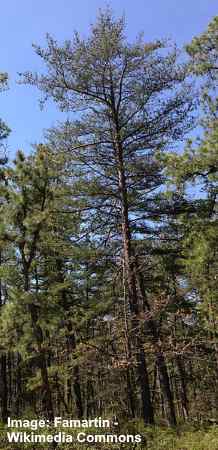
Virginia pine trees grow in Northern Florida
The Virginia pine tree is not native to Florida, but it grows well in its northern regions. This small pine tree grows 15 to 40 ft. (4.5 – 12 m) and has an irregular crown. The short pine needles grow in bundles of two and are a yellowish-green color.

Virginia pine cone and needles
Other identifying features of the Virginia pine are shaggy, reddish-brown to orange bark and small, spiny-scaled cones. The pine tree’s needles and prickly cones grow 1.5” – 8” (4 – 8 cm). The cold-hardy conifer is suitable for USDA zones 4 through 9 in full sun.
Japanese Black Pine (Pinus thunbergii)
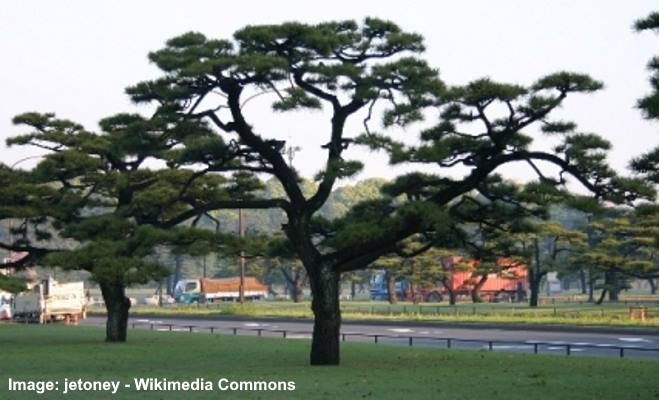
Japanese black pine is native to Japan but grows well in Florida
The Japanese black pine grows well in Florida but is native to Japan and the far east. The tall ornamental pine has shrub-like growth and horizontally-spreading branches. Japanese black pines in Florida grow up to 130 ft. (40 m) tall and thrive in USDA zones 6 through 8.
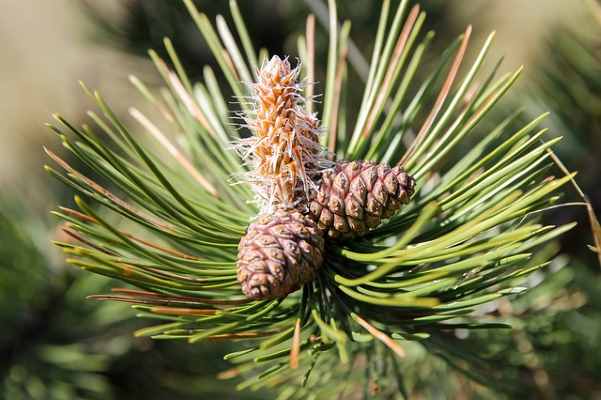
Japanese black pine needles and cones
Non-native Japanese black pines are identified by their long bright green needles measuring 3” – 4.5” (8 – 11 cm) long. Their cones are conical in shape and measure 1.5” (4 cm) long. Compared to native Florida conifers, the Japanese black pine needles are stouter and sharper.
The best region in Florida for growing Japanese black pines is along the Panhandle.
Related articles:
- Types of Pine Trees – Identification Guide
- Types of Pine Cones – Identification Guide
- Ultimate Conifer Identification Guide: Pine, Fir, and Spruce
